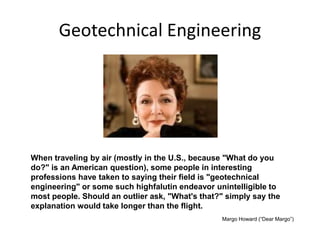The 5-Minute Rule for Geotheta
The 5-Minute Rule for Geotheta
Blog Article
Excitement About Geotheta
Table of ContentsThe 4-Minute Rule for GeothetaThe Single Strategy To Use For GeothetaThings about GeothetaFascination About Geotheta
They work together with civil designers, architectural designers, architects, and other professionals to integrate geotechnical considerations into the general project style and building and construction procedure. This requires effective team effort, coordination, and communication to ensure that the geotechnical facets straighten with the task goals and satisfy regulative requirements.Mining & Materials Engineering: Concepts of drilling, infiltration rates, and aspects influencing the option of boring method. Qualities of explosives, shooting systems and blast patterns. Blowing up methods in surface and underground workings. Unique blowing up techniques at excavation borders. Resonance and noise control. Mechanical and constant techniques to fragmentation, including longwall shearing and fullface boring.
Integrated evaluation of fragmentation and comminution operations. Supplied by: Mining & Materials Design.
Unknown Facts About Geotheta
Bachelor's degree programs in civil, geotechnical, geological, and environmental engineering usually last 4 years and include general education and learning courses in English, social science, and the humanities, as well as training courses in advanced maths, structural geology, and fluid mineralogy. (https://flossy-rotate-3d1.notion.site/Why-Geotechnical-Engineers-are-Vital-for-Your-Construction-Projects-7c147cf012a34d1abe5134afbabc811f?pvs=4)
Geotechnical design entails the evaluation of the soil and rock problems at a specific site, and their implications for the advancement of that site. As many structures count on the ground for assistance, it is without surprise that a thorough understanding of the ground conditions, and the viability of foundation systems, are vital to the long-lasting stability and efficiency of the building or structure.
Being experts in the investigation of geological formations and ground behaviour, geotechnical engineers do clinical investigations and screening to recognize the impact these geological formations may have on the style and building of building, civil and facilities tasks. This experience is vital for the design and construction of structures, roads, passages, dams, bridges, and water system and sewer system.
The geotechnical group at Douglas Allies routinely talk to designers, style engineers, developers, and contractors to make suggestions on layout and advancement propositions to ensure that the developed structures are appropriately created for the ground problems. The layout of footing systems requires to consider the weight of the structure, the capability of the ground to sustain that weight with each other with movement resistances and effective building and construction.
The smart Trick of Geotheta That Nobody is Talking About
This task is considerably streamlined by the use our Douglas Map geospatial system which makes this info conveniently available in an easy to utilize web browser interface. A geotechnical engineer will certainly guide the boring of boreholes and examination pits to collect soil and various other examples, and likewise analyze surface attributes and ground exposures to develop a geotechnical version of the subsurface conditions.
Relying on the task type and ground conditions came across, research laboratory screening might amongst other points assess toughness, compressibility, reactivity and/or permeability of soil and rock examples. Hereafter information is gathered and looked at, the results are used for a geotechnical version of the site, which is typically provided as sections throughout the site.

A geotechnical investigation by nature can just evaluate the ground conditions at the locations pierced or dug deep into. Natural variants in dirt and rock problems can occur across a website and in between examination areas. It is consequently excellent technique that the geotechnical designer be kept throughout construction of the task to provide on-site verification that the ground conditions come across are constant with the expectations and recommendations supplied in the geotechnical investigation record.
Indicators on Geotheta You Should Know
Geotechnical designers use their in-depth knowledge of soil and rock to evaluate threat and solve troubles on diverse framework projectsGeotechnical design is a specialist branch of civil design which checks out the behaviour of planet materials and the application of dirt and rock technicians. Geotechnical Engineers. As a geotechnical designer, you will analyze the physical, mechanical and chemical properties of soil and rock in order to create structures, keeping structures and earthworks
Geotechnical design is carefully linked to and overlaps with, both design geology and ground design - https://www.producthunt.com/@geotheta1. It's feasible to be experts in geotechnics or work for a geotechnical firm but be called an engineering geologist or a ground engineer. As a geotechnical designer, you'll require to: construct and maintain connections with clients and various other professionals involved in the site, throughout each projectmaintain security standards on website bear in mind cost effects when you make recommendationsstudy geological maps and airborne photographs from a variety of resources and from different time periodsexamine building plans to see just how viable they are based on your understanding of the siteinvestigate threats or geological risks pop over to this site for the sitesearch for environmentally delicate features, such as land fill begin to establish valid and expository ground modelsplan field investigationsdrill and evaluate examples of bedrock, soil, groundwater and extra materials oversee other professionals on sitesolve technological issues as they emerge, such as unforeseen frameworks at drill sitesmonitor problems during and after building and construction to make sure frameworks are secure in the short and long termadding data accumulated on site to your preliminary researchcreating geotechnical estimations, drawings, and 2 or three-dimensional computer models interpreting the datamaking recommendations concerning the proposed use the site

Report this page